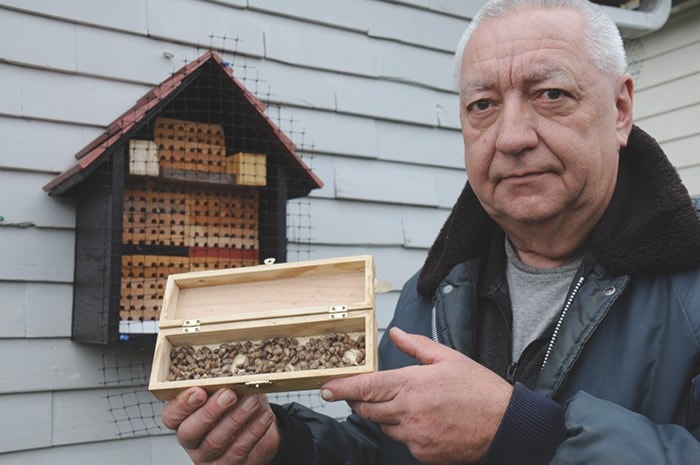Ed Marshall grows garlic and other vegetables in his backyard garden in Port Alberni. But above eye level, he is cultivating another integral part of the growing cycle: mason bees.
Marshall started out with 10 cocoons a few years ago, more out of curiosity and the desire to give nature a helping hand than anything.
“I’ve got thousands now,” he says.
Marshall’s interest in mason bees increased a few years ago, when he began reading more and more about the honey bee crisis—they are dying off by the millions due to Colony Collapse Disorder.
In the past three years, Marshall hasn’t seen one honey bee in his backyard garden. “I’ve seen bumblebees, mason bees and summer bees, but no honey bees,” he said.
Mason bees are smaller than some other bees, and they don’t sting. “Some people mistake them for flies,” he said.
Although honey bees have had a lot of press in the past few years because they are mysteriously dying off, they are not the only bees that pollinate flowers and plants. In the publication Farming for Bees, the author notes bees native to their respective regions are as effective—if not more—than honey bees in pollinating flowers and crops.
For instance, 250 female orchard mason bees can pollinate an acre of apples—a task that would take up to two honey bee hives, or nearly 20,000 foragers. In Nova Scotia, there are 67 species of native bees that pollinate blueberry bushes.
 In Port Alberni, the mason bees will last until the beginning of June; then they give way to summer bees, Marshall said.
In Port Alberni, the mason bees will last until the beginning of June; then they give way to summer bees, Marshall said.
“These guys are already native to this part of the country,” Marshall said.
Mason bees are also easy to look after: “In nature they look after themselves anyway and they’ve always been here,” he explained.
He said the bees favour sunlight, so many of the bee houses he has up at his home are placed for maximum sun exposure. He says securing them up near the eaves is ideal.
The egg-laying season is relatively short: mason bees began hatching in mid-April and they will be finished by early June. The females lay eggs inside the tubes of a mason bee house, packing mud in between the eggs until the tubes are full.
Mason bee houses can either be turned around to protect the incubating eggs from predators like flickers, or stored in a shed (not in the house) until next spring.
Marshall has his own system for cultivating his mason bees. He lines his houses with homemade parchment paper tubes and in October and November he removes the tubes, takes out the cocoons, washes and separates them (male cocoons are smaller) then stores them in small wooden boxes he buys at the dollar store. “I like to separate them so I know what’s what,” he said. “I know for sure my bees are clean.”
Next March, Marshall can be found at the Farmer’s Market and at Arrowvale Farm Market.
editor@albernivalleynews.com
Twitter.com/AlberniNews
